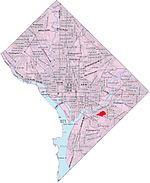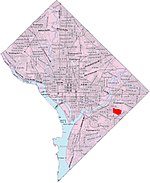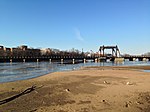Twining (Washington, D.C.)
Neighborhoods in Southeast (Washington, D.C.)Washington, D.C., geography stubs

Twining is a neighborhood in Southeast Washington, D.C., near the eastern bank of the Anacostia River. It is bounded by Minnesota Avenue NE to the northeast, Branch Avenue to the northwest, and Pennsylvania Avenue to the south. The Fort Dupont year-round ice skating rink, and the Smithsonian's Anacostia Neighborhood Museum are nearby. It is named for Major William Johnson Twining, who served as Military Commissioner of the District of Columbia from 1878 until his death in 1882.
Excerpt from the Wikipedia article Twining (Washington, D.C.) (License: CC BY-SA 3.0, Authors, Images).Twining (Washington, D.C.)
Pennsylvania Avenue Southeast, Washington
Geographical coordinates (GPS) Address Nearby Places Show on map
Geographical coordinates (GPS)
| Latitude | Longitude |
|---|---|
| N 38.8714 ° | E -76.9658 ° |
Address
Pennsylvania Avenue Southeast 2919
20020 Washington
District of Columbia, United States
Open on Google Maps








